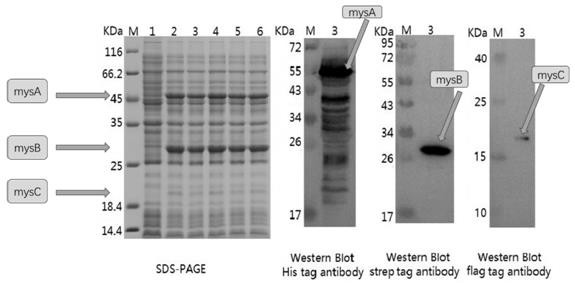Antarctic ice algae MAAs synthetases as well as coding genes and application thereof
An Antarctic ice algae and coding gene technology, applied in the field of biology, can solve problems such as separation and purification of functional activity and research difficulties in mechanism of action, and achieve the effect of alleviating negative damage, significant significance and huge social benefits
- Summary
- Abstract
- Description
- Claims
- Application Information
AI Technical Summary
Problems solved by technology
Method used
Image
Examples
Embodiment 1
[0054] Example 1. The cultivation and whole genome sequencing of Antarctic ice algae
[0055] The total sequencing volume of the Antarctic ice algae genome is 43.76 G, with a coverage depth of 71.07 X. In addition, the second-generation small fragments and 10X Genomic library were constructed and sequenced using the illumina platform. Using the Antarctic ice algae genome 103.70 G sequencing data, the sequencing depth was 168.43 X. The Antarctic ice algae genome was denovo assembled to identify its species.
[0056] The assembly results are as follows: the total length of the contig is 532.13 Mbp, and the contig N50 reaches 209.56 Kbp; the total length of the scaffold is 541.31 Mbp, and the scaffold N50 reaches 490.02 Kbp. It was identified as Antarctic ice algae by bioinformatics Chlamydomonas sp. . ICE-L.
Embodiment 2
[0057] Embodiment 2. Antarctic ice algae Chlamydomonas Acquisition of cDNA sequence of sp. ICE-L MAAs synthetase (MysA, MysB, MysC)
[0058] 1. Extraction of total RNA from Antarctic ice algae
[0059] Using Invitrogen's Trizol reagent to extract Antarctic ice algae cultured to the logarithmic phase at 4°C Chlamydomonas sp. ICE-L RNA. The test was carried out according to the extraction process instructions of Trizol reagent, and no RNase contamination was ensured throughout the process, and the extracted RNA was frozen and stored in a -80°C refrigerator for later use.
[0060] 2. Acquisition of cDNA sequence of MAAs synthetase gene of Antarctic ice algae
[0061] Extract high-quality RNA according to PrimeScript 1 st The strand cDNA Synthesis Kit (TaKaRa) manual was used to perform reverse transcription and synthesize cDNA. The specific operation steps are as follows:
[0062] (1) Mix the following systems evenly:
[0063] Template RNA 0.6 μL
[0064] Oligo dT Pri...
Embodiment 3
[0091] Example 3. Antarctic ice algae Chlamydomonas sp. ICE-L MAAs synthetase gene ( MysA , MysB , MysC ) construction of expression vector and heterologous expression in Escherichia coli
[0092] 1. Design primers according to the complete sequence of the MAAs synthetase gene obtained by sequencing:
[0093] MysAExpression primers:
[0094] MysA -F: ATGTCGTTCCGCCCCAAACT;
[0095] MysA -R:GCAGAAGTGATTCAAAGTCTCCTCC;
[0096] MysB Expression primers:
[0097] MysB- F: ATGCAAGTGTCCCTGAAGGGA;
[0098] MysB- R: CCGTTTTCGGCACAAAGCAA;
[0099] MysC Expression primers:
[0100] MysC- F: ATGCCACTTGGTGGCACTTCC;
[0101] MysC- R: GCTGCCCCCGGCATCCT.
[0102] The PCR reaction conditions were: pre-denaturation at 95°C for 10 min; denaturation at 95°C for 15 s, annealing at 55°C for 1 min, extension at 72°C for 2 min, and repeated 30 cycles.
[0103] 2. Utilize the PCR method to pass the above primers to MysA Add 6×his-tag to the C-terminus of the DNA, optimiz...
PUM
 Login to View More
Login to View More Abstract
Description
Claims
Application Information
 Login to View More
Login to View More - R&D
- Intellectual Property
- Life Sciences
- Materials
- Tech Scout
- Unparalleled Data Quality
- Higher Quality Content
- 60% Fewer Hallucinations
Browse by: Latest US Patents, China's latest patents, Technical Efficacy Thesaurus, Application Domain, Technology Topic, Popular Technical Reports.
© 2025 PatSnap. All rights reserved.Legal|Privacy policy|Modern Slavery Act Transparency Statement|Sitemap|About US| Contact US: help@patsnap.com



